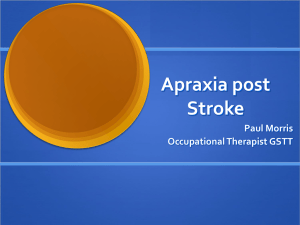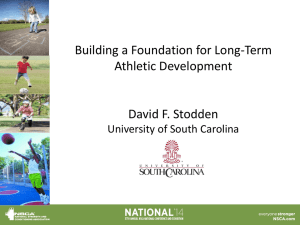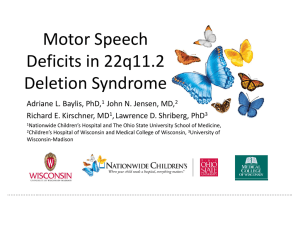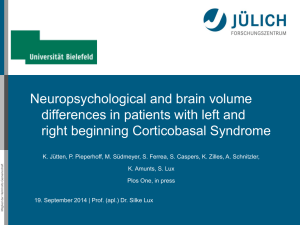Apraxia talk no videos - Metro Speech Language Network
advertisement
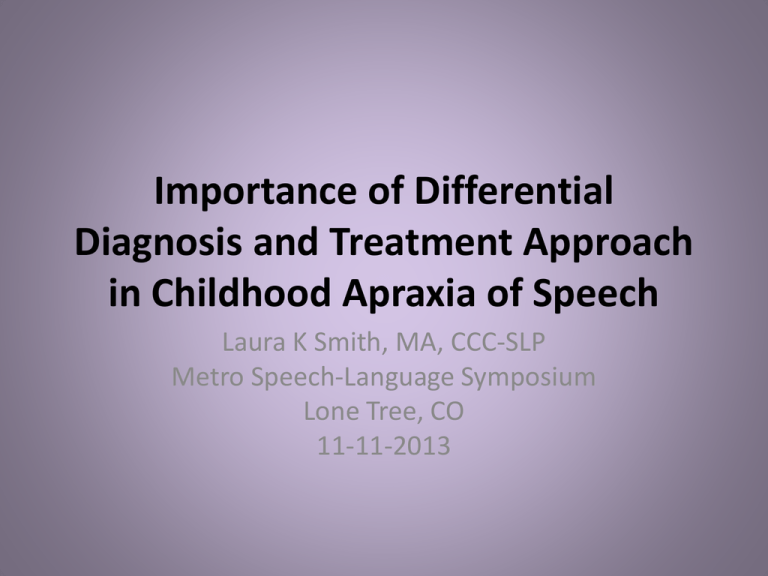
Importance of Differential Diagnosis and Treatment Approach in Childhood Apraxia of Speech Laura K Smith, MA, CCC-SLP Metro Speech-Language Symposium Lone Tree, CO 11-11-2013 About me • I’m a Denver Native • Received my BA from MSCD • Received MA from UNC distant learning program • Currently work for DPS and Lowry Speech Therapy • Live with my husband and two kids • My daughter was dx with CAS at 2yrs 11mo Ashlynn’s fourth Birthday First time singing Happy Birthday Song! First time blowing out her candles on her own! Importance of early intervention • Importance of early intervention is well documented throughout the literature • Importance of early intervention for CAS requires differential diagnosis. Techniques designed for typical speech and language delays are not effective treatment approaches for CAS. • Principles of motor learning theory should drive therapy. (11/6/07 ASHA Leader, Magill 1998, Schmidt 2004). Speech disorders • Speech Sound Disorders – Articulation – Phonological Processing • Motor Speech Disorders – Childhood Apraxia of Speech – Dysarthria What is Childhood Apraxia of Speech (CAS)? • Childhood apraxia of speech (CAS) is a neurological childhood (pediatric) speech sound disorder in which the precision and consistency of movements underlying speech are impaired in the absence of neuromuscular deficits (e.g., abnormal reflexes, abnormal tone). CAS may occur as a result of known neurological impairment, in association with complex neurobehavioral disorders of known or unknown origin, or as an idiopathic neurogenic speech sound disorder. The core impairment in planning and/or programming spatiotemporal parameters of movement sequences results in errors in speech sound production and prosody. (ASHA technical report, 2007) Definition continued (ASHA, 2007) • Three generally agreed upon diagnostic markers – inconsistent errors on consonants and vowels in repeated productions of syllables or words – lengthened and disrupted co-articulatory transitions between sounds and syllables (difficulty moving from one sound to the next, or one syllable to the next) – inappropriate prosody, especially in the realization of lexical or phrasal stress. (may sound monotone, robotic, and may have a tendency to always stress the first syllable etc.) Other Diagnostic indicators (ASHA, 2007) • • • • • • • - little to no babbling as a baby - lack of vowel variation; overuse of schwa - vowel distortion -regression or loss of once produced words - impaired rate/accuracy on diodochokinetic tasks - higher receptive versus expressive language - impaired volitional oral movements (oral apraxia), groping • - makes inconsistent sound errors, or may produce target accurately in one context, but not another. Non-speech motor signs • Non-speech motor signs of CAS that are most commonly proposed in the literature (some of which are also cited as signs of dysarthria) include the following: general awkwardness or clumsiness, impaired volitional oral movements, mild delays in motor development, mildly low muscle tone, abnormal oro-sensory perception (hyper- or hyposensitivity in the oral area), and oral apraxia (e.g., Davis et al., 1998; McCabe et al., 1998; Shriberg et al., 1997a). The non-speech motor features typically listed for oral apraxia are impaired volitional oral movements (imitated or elicited postures or sequences such as “smilekiss”) and groping (e.g., Davis et al., 1998; McCabe et al., 1998; Shriberg et al., 1997a). Motor Speech Examination (Strand 1996, Stoeckel 2005) • Examine ability to sequence phonetic sequences in various contexts. – CV, VC, and CVC combos using various vowels – Mono and multi-syllabic word repetitions – Phrase and sentence repetition increasing sentence length. * Not a lot of commercially available tests on the market for this. One used at my clinic is the Kaufman Speech Praxis Test for Children. Motor speech Exam continued • Vary temporal relationship between stimulus and response – Simultaneous – Immediate vs. delayed repetition Evaluate Prosody! Causes? • No known cause to date for all cases • Researchers in 1998 discovered a gene that causes CAS called FOXP2. However, only a small percentage of children with CAS had FOXP2 abnormalities. • Idiopathic CAS can run in families. • It can also be diagnosed in children where there is no family history of CAS. • Can be the result of a neurological impairment caused by infection, illness, or injury before or after birth, which may, or may not show up as positive findings on MRI scans. A note about Ashlynn’s characteristics • Low muscle tone, open mouth posture, drooled excessively as a baby, even when not teething • Army crawled at 9 months, walked at 17 months, used whole hand to point, couldn’t imitate signs • Very clumsy. Impaired balance • Would forget to masticate during the swallow (choke risk!) • Oral apraxia – couldn’t pucker, kiss, or blow Comparison Chart (CASANA advisory board) Verbal Apraxia Severe Phonological processing disorder • Inconsistencies in articulation performance–the same word may be produced several different ways • Consistent errors that can usually be grouped into categories (fronting, stopping, etc.) • Errors include substitutions, omissions, additions and repetitions, frequently includes simplification of word forms. Tendency for omissions in initial position. Tendency to centralize vowels to a “schwaa” • Errors may include substitutions, omissions, distortions, etc. Omissions in final position more likely than initial position. Vowel distortions not as common. • Number of errors increases as length of word/phrase increases • Errors are generally consistent as length of words/phrases increases Comparison chart continued (CASANA advisory board) Verbal apraxia Severe Phonological Processing Disorder • Well rehearsed, “automatic” speech is easiest to produce, “on demand” speech most difficult • No difference in how easily speech is produced based on situation • Receptive language skills are usually significantly better than expressive skills • Sometimes differences between receptive and expressive language skills • Rate, rhythm and stress of speech are disrupted, some groping for placement may be noted • Typically no disruption of rate, rhythm or stress A controversial diagnosis • Diagnostic indicators vary in the research from study to study. • There is currently no gold standard, that when identified, leaves little doubt that CAS is present • CAS characteristics can overlap with phonological processing characteristics • Clinicians in the field have devised their own diagnostic schemas • Leads to potential misdiagnosis/over diagnosis How early to diagnose • A note about age – Difference between a “late talker” and CAS • Generally speaking, regardless of age, a child can be diagnosed with CAS if they can commit to a full motor speech examination. Why is differential diagnosis important? • In a word: TREATMENT!!! • Children diagnosed with CAS need a motor based speech approach to therapy • Traditional articulation and phonological therapies are not successful for children with CAS (Cycles, minimal pairs, maximum opposition, etc) – These approaches are designed to remediate a sound, or sound error patterns. What is a motor based approach to therapy? • Focuses on the planning, sequencing, and coordination of muscle movements for the development of intelligible speech • It does NOT include oral motor exercises designed to strengthen the oral/motor musculature, since apraxia is an issue of motor planning, not motor weakness. • Motor planning approaches include: integral stimulation (Strand & Debertine, 2000), as well as other commercially available approaches: The K-SLP, PROMPT, and SpeechEZ. – Research is ongoing to prove the efficacy of these programs. – Integral Stimulation (DTTC) and PROMPT have demonstrated effectiveness in the literature (Strand & Debertine, 2000; Dale & Hayden, 2013) – Integral stimulation emphasizes auditory and visual models – Other programs emphasize tactile and/or gestural cues Motor learning theory (Schmidt 1988, Stoeckel 2005) • Three factors relevant to the treatment of motor speech disorder: – Prepractice – Conditions of practice – Knowledge of results and effects of rate Motor learning continued Pre-practice Inspire motivation Conditions of practice Awareness of goal Frequent practice Repetitive motor drill Mass vs. Distributed Blocked vs Randomized • Knowledge of Results – Give child frequent information about movement performance Therapy strategies • Ancillary learning techniques do NOT work for CAS. • Oral motor exercises are NOT reported in any literature to improve CAS. If you want to improve speech, work on speech! • Develop a core vocabulary list/book (Hammer 2005, Kaufman 2013) • Start with simple syllable shapes and move up the hierarchy incorporating principles of motor learning. Other strategies that work - Stabilize vowels - Successive approximations (Kaufman 2013) - Built confidence! Follows typical phonology patterns - Errorless teaching (Kaufman 2013) - Use of some type of visual or tactile cue (Hammer 2013, Kaufman 2013, Stoeckel 2013) - Key is consistency - Backward chaining Strategies Continued • Don’t forget language! – Carrier phrases – Pivot phrases (Kaufman 2013) – Repetitive books – Modeling, recasting, expansion and repetition techniques Case in Point • Video Olivia 3.7 • Early intervention since 2 years • Came with 3 words and maybe 10 word approximations Olivia 4:11 • Motor based approach to therapy initiated. • Only seen client 1x week for 45 minutes • Went from 10 words to over 50 and combining words in her repertoire Resources • • • • Apraxia-kids.org http://www.kidspeech.com/ http://slpmommyofapraxia.blogspot.com/ Facebook pages – APRAXIA KIDS: Every Child Deserves a Voice – Apps for Apraxia Kids – Apraxia Bloggers – Colorado Families Living with Apraxia Bibliography/References • • • • • • • • • • • American Speech-Language-Hearing Association (2007). The technical report on childhood apraxia of speech. www.asha.org/policy American Speech-Language-Hearing Association. (2007). Childhood apraxia of speech (position statement). www.asha.org/policy Beate, P. (2013) Childhood Apraxia of Speech in Multigenerational Families: Genes and Generations. Childhood Apraxia of Speech Symposium, Denver, CO. Childhood Apraxia of Speech Association of North America. (2005). Key characteristics of childhood apraxia of speech. www.apraixa-kids.org Dale, P. & Hayden, D. (2013) Treating speech subsystems in Childhood Apraxia of Speech with tactual input: The PROMPT Approach. American Journal of Speech/Language Pathology. Gildersleeve-Neumann, C. (2007, November 06). Treatment for Childhood Apraxia of Speech : A Description of Integral Stimulation and Motor Learning. The ASHA Leader. Hammer, D. (2013) A Multi-Sensory Approach for Childhood Apraxia and Speech Sound Disorders. Metro Speech-Language Symposium, Denver, CO. Jakielski, K. (2013) State of the Art in Childhood Apraxia of Speech Research: A synopsis of the 2013 Childhood Apraxia of Speech Symposium, Denver, CO. Kaufman, N. (2013) The Kaufman Speech to Language Protocol: Effective Strategies for CAS. National Conference on Childhood Apraxia of Speech, Denver, CO. Stoeckel, R. (2005) Childhood Apraxia of Speech: Assessment and Treatment, Aurora, CO. Stoeckel, R. (2013) Dynamic Temporal and Tactile Cueing (DTTC): Why, When, How. National Conference on Childhood Apraxia of Speech, Denver, CO.
